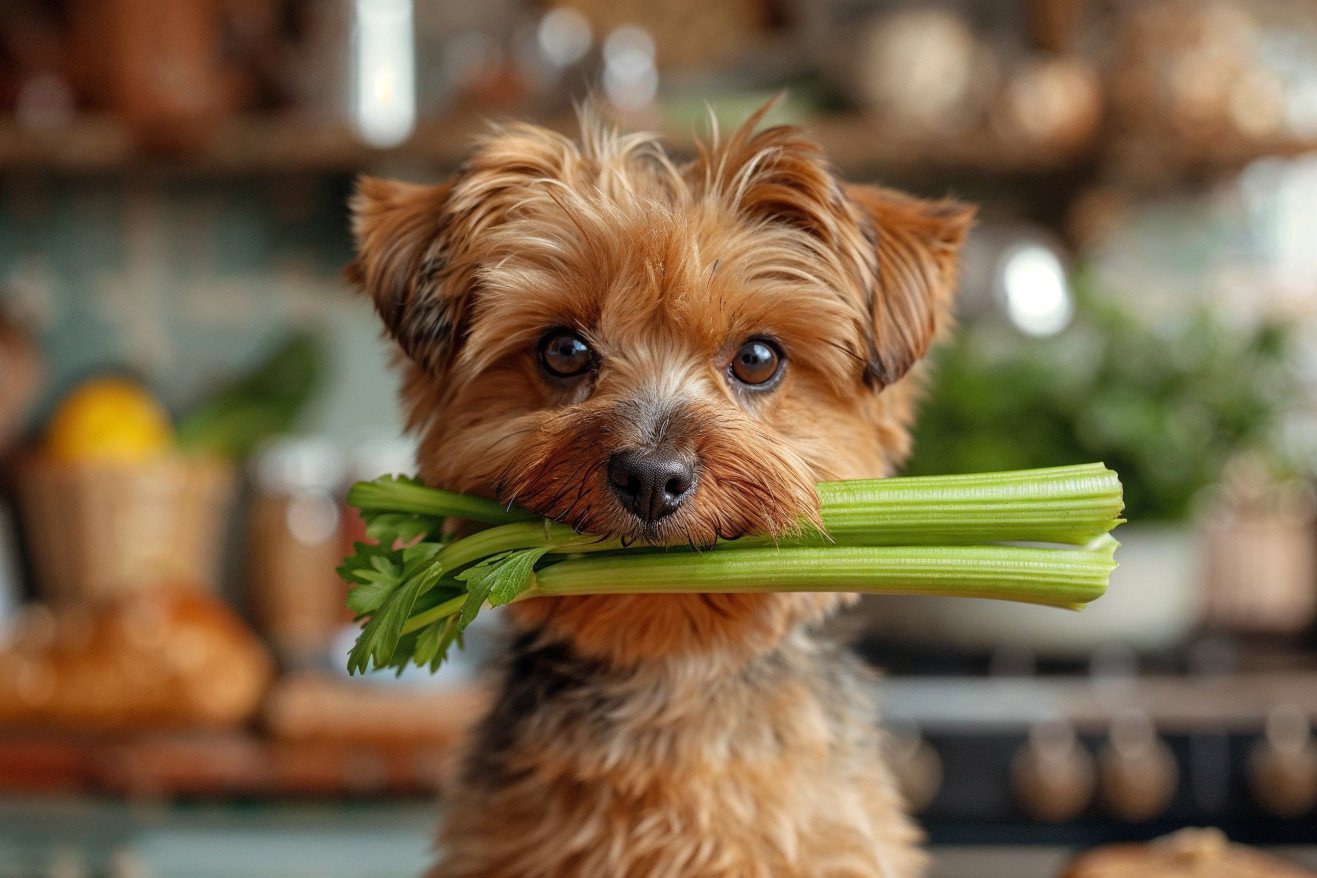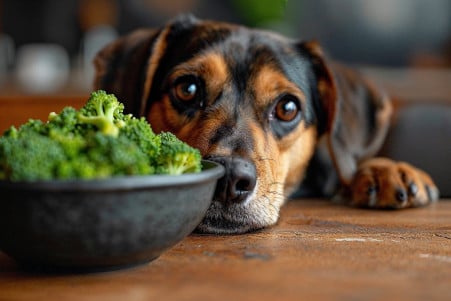Can Dogs Eat Celery? A Guide to Safe Snacking for Your Pet
24 January 2024 • Updated 28 January 2024

Celery is a popular human snack, but can you share it with your dog? The answer is yes, dogs can eat celery in moderation. Celery is low in fat and cholesterol, and it has vitamins and fiber, which can help with hydration and digestion.
That said, it’s important to make sure the celery is cut into small, manageable pieces to avoid choking, and to limit the amount of celery you give your dog to avoid digestive issues.
To give you a complete picture of what it means to feed your dog celery, we’ve looked at a number of studies in veterinary science, dog nutrition, and food safety. We’ve also talked to experts about the nutritional value and potential downsides of adding celery to your dog’s diet.
We’ve included information on how much celery to give your dog and how to introduce new treats to your pet. With this information, you can decide whether or not to add celery to your dog’s diet as a healthy treat.
Can dogs eat celery?
Celery: A Healthy Addition to Your Dog’s Diet
In addition to being a satisfying snack, celery is also packed with nutrients. According to Rogue Pet Science, celery is a great source of important vitamins like K, C, and A, which help with blood clotting, the immune system, and eye health, respectively. Meanwhile, minerals like potassium and magnesium, which are also found in celery, are important for dogs because they help with nerve and muscle function.
Wild Earth also notes that celery is low in calories, which makes it a good option for dogs who are trying to lose or maintain their weight. Since celery should only make up a small percentage of a dog’s daily calories, it can be a good way to help them stay full without adding extra calories.
In addition, Raw Bistro says that celery is made up of about 95% water, which makes it a great way to help dogs stay hydrated. This is especially important in the summer when dogs may need a little extra help staying hydrated.
While celery can help with these things, it’s important to remember that it should be part of a balanced diet, not a replacement for one. That said, feeding your dog a balanced diet that includes the right amount of celery can help support their health.
How to Properly Give Your Dog Celery
As with any treat, it’s important to give your dog celery in moderation. The AKC Canine Health Foundation recommends that treats, including celery, should make up no more than 10% of your dog’s daily caloric intake.
To make sure that your dog can eat celery safely and without the risk of choking, it’s important to prepare it properly. This means removing the leaves, which tend to have more pesticides, and cutting the stalks into small, bite-sized pieces, especially for smaller dogs.
It’s also important to introduce celery, or any new food, into your dog’s diet slowly. As Dr. Jerry Klein, DVM, Chief Veterinary Officer of the AKC explains, this will help you keep an eye on your dog for any adverse reactions, such as allergies or stomach issues.
Make sure that you give your dog celery raw or cooked, and that it doesn’t have any added salt, toxic ingredients like onions or garlic, or “ants on a log”, which includes raisins that are toxic to dogs.
When giving your dog celery as a treat, make sure to take your dog’s size and weight into account to determine the right portion size. By following these simple guidelines, you can give your dog a healthy treat while still making sure that their diet is well-rounded and good for them.
How to Tell If Your Dog Has a Food Sensitivity
When you’re feeding your dog new foods, even healthy treats like celery, it’s important to keep an eye out for signs of food sensitivities or allergies. According to the VetDERM Clinic, common signs of food allergies in dogs include itchy skin, gastrointestinal problems like diarrhea and vomiting, and frequent ear infections.
The American Kennel Club also notes that these symptoms can come on suddenly and be quite severe, even if your dog has been eating the food in question for a while.
To diagnose a food allergy, vets often recommend an elimination diet, which is a special feeding plan that eliminates the food that’s suspected to be causing the allergy. PetMD also notes that it’s important to make sure that any dietary changes, including new treats, are introduced slowly to avoid stomach upset and make it easier to figure out exactly what’s causing a reaction.
If your dog has an allergic reaction to celery, it’s important to talk to your vet. They can help you figure out how to manage your dog’s sensitivities and may be able to recommend other treats that will help you keep your dog’s diet varied without causing them any health problems.
By keeping an eye on your dog’s reaction to new foods and following your vet’s advice, you can make sure that your dog’s diet is both fun and safe.
A Smorgasbord of Dog-Safe Human Foods
The American Kennel Club notes that, among other dog-safe human foods, celery is a good choice because it’s low in calories and high in water. But celery isn’t the only option. Carrots are another source of vitamins and fiber for dogs, and they can help keep your dog’s teeth clean.
Apples are a source of vitamins A and C and fiber, but make sure to remove the seeds, which can be toxic and lead to cyanide poisoning. Cooked, unseasoned chicken and turkey are good sources of protein, and blueberries are a source of antioxidants.
It’s important to make sure you’re offering a mix of these foods in moderation to ensure that your dog’s diet is well-rounded and that they don’t get too much or too little of any one nutrient.
There are also some human foods that are toxic to dogs and should be avoided at all costs, including grapes, raisins, chocolate, and anything that contains the artificial sweetener xylitol, all of which can cause serious health problems for dogs.
In general, you can think of celery as a model and make sure to look up the safety and nutritional value of any human food before you give it to your dog. This way, you can make sure you’re offering your dog a variety of foods that are safe and healthy for them.
In Summary: Celery and Your Dog’s Diet
As you can see, celery can be a safe and healthy snack for dogs when given in moderation. It’s packed with vitamins, including vitamins K, C, and A, and important minerals such as potassium and magnesium, which can help with a variety of health issues. Plus, its high water content can help keep dogs hydrated, especially when they’re active on hot days.
Of course, how you serve it is just as important as the benefits it offers. Make sure to cut up the celery into bite-sized pieces to avoid a choking hazard and to ensure that it’s treated as a treat and not a meal. While celery can be a great addition to your dog’s diet, make sure to watch for any signs of food sensitivities or allergies when you introduce new foods.
In short, treats like celery can be a healthy addition to your dog’s diet, providing both nutrition and variety. However, they should always be part of a complete and balanced diet that meets your dog’s individual needs. By following these tips, you can help keep your dog healthy and happy, one crunchy bite at a time.


